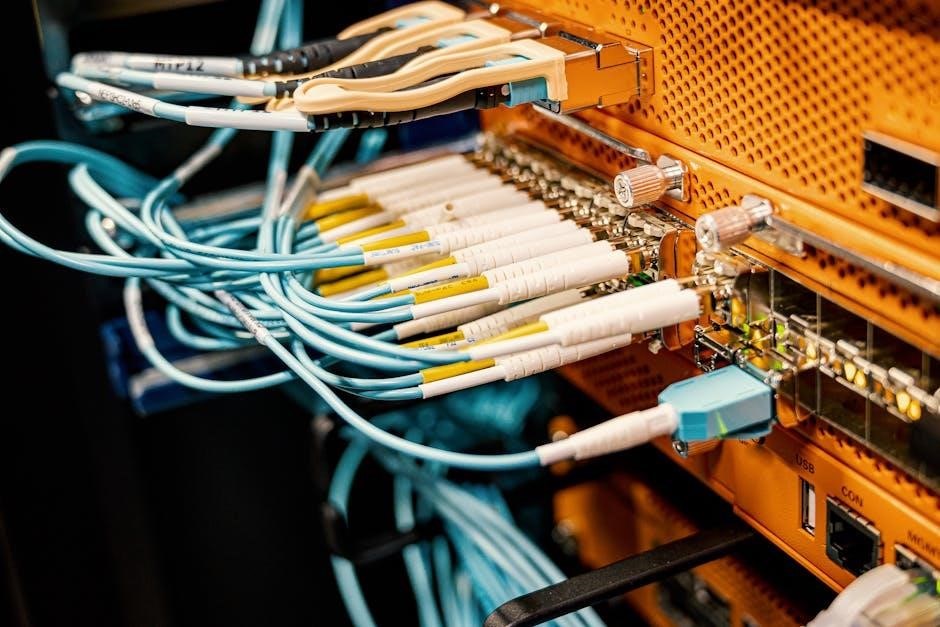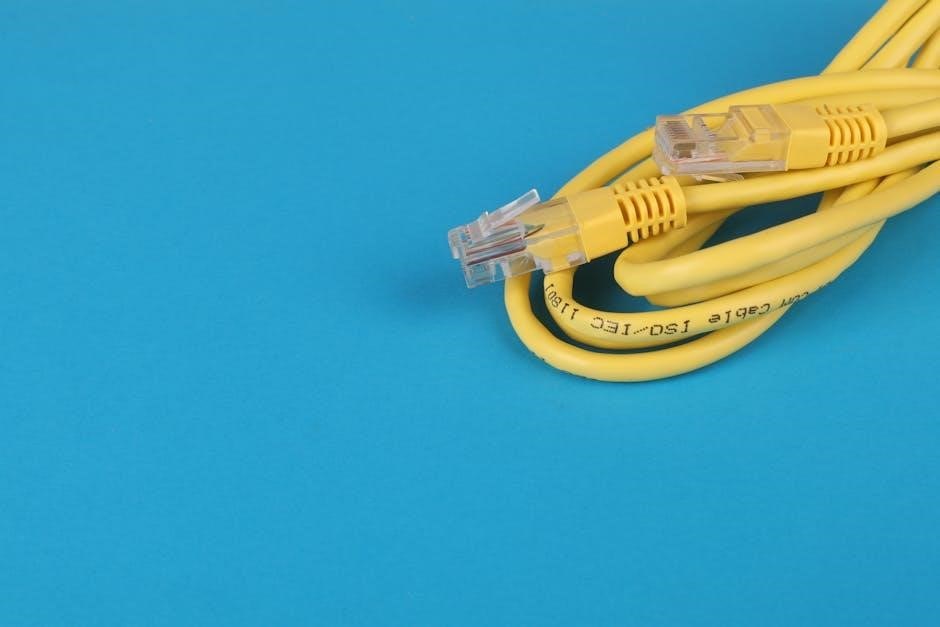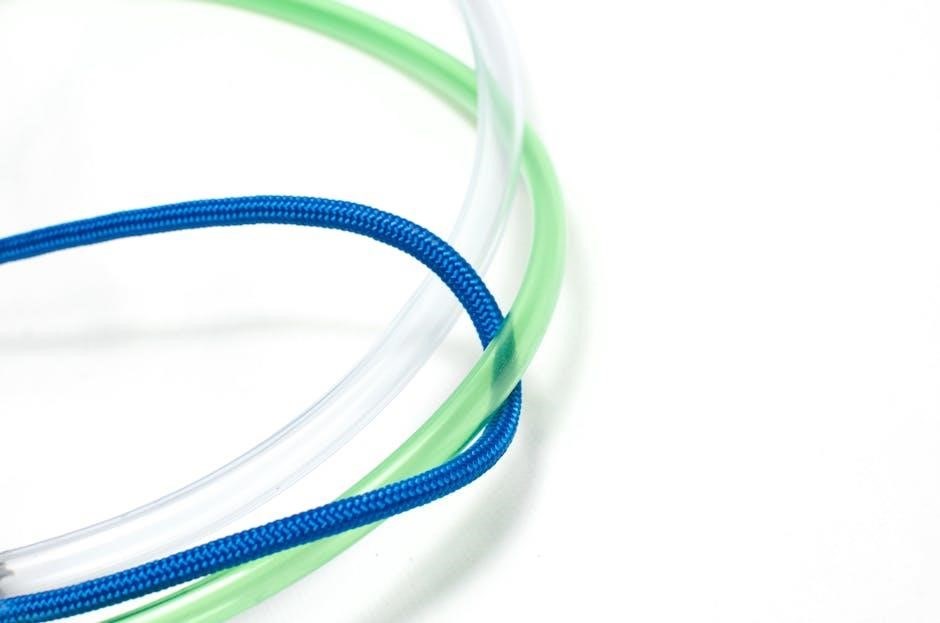color coding of lan cable pdf
LAN cable color coding, detailed in readily available PDF resources, ensures reliable Ethernet connectivity. Standardized color codes, like T568A and T568B, are vital for predictable data transmission.
What is LAN Cable Color Coding?
LAN cable color coding is a standardized system utilizing specific color sequences for the eight wires within an Ethernet cable. These sequences, often found in PDF guides, aren’t arbitrary; they dictate how the wires are arranged within the RJ45 connector. This standardization, encompassing T568A and T568B, ensures compatibility and reliable data transmission across network devices.
The color coding allows technicians to consistently create cables, whether straight-through, crossover, or rollover, without guesswork. PDF documentation details these wiring schemes, illustrating the precise order of wires. Properly implemented color coding minimizes signal interference and maximizes network performance, making it a fundamental aspect of network infrastructure. It’s a crucial element for both businesses and home networks.
Why is Color Coding Important?
Color coding is paramount for establishing dependable Ethernet connections, as detailed in numerous PDF resources. Consistent color arrangements minimize crosstalk and signal degradation, ensuring optimal data transfer speeds. Utilizing standardized schemes like T568A or T568B, outlined in PDF wiring diagrams, guarantees compatibility between devices.
Incorrect wiring, easily avoided with proper color coding, can lead to network instability or complete failure. PDF guides assist technicians in accurately terminating cables, reducing troubleshooting time and costs. Furthermore, standardized color coding simplifies network maintenance and future expansions. Adhering to these standards, readily available in PDF format, is essential for robust and reliable network performance.

Understanding the T568A and T568B Standards
PDF guides detail both T568A and T568B, the primary Ethernet cabling standards. These color coding schemes dictate wire arrangement within LAN cables for optimal performance.
T568A Wiring Standard
PDF documentation illustrates the T568A standard as beginning with a white-green wire, followed by a green wire, then white-orange, blue, white-blue, orange, white-brown, and brown. This scheme is often favored in installations where patch panels utilize punch-down blocks, as it maintains consistent wiring polarity.
Numerous online color coding charts, available as PDF downloads, visually represent this arrangement. Understanding the T568A standard is crucial for creating straight-through cables when both ends will adhere to this specific configuration. It’s important to carefully follow the PDF diagrams to avoid errors during cable termination, ensuring reliable Ethernet connectivity. Proper implementation, guided by these resources, minimizes signal degradation and maximizes network performance.
T568B Wiring Standard
PDF guides detail the T568B standard, initiating with an orange-white wire, followed by orange, white-blue, blue, white-green, green, white-brown, and brown. This is the more commonly used standard in North America, often preferred for direct connections between devices.
Many downloadable PDFs showcase this color coding sequence visually. Utilizing the T568B standard for both ends of a cable creates a straight-through connection. Accurate adherence to these PDF-provided diagrams is essential during crimping to guarantee optimal network performance. Incorrect wiring, as highlighted in troubleshooting PDFs, can lead to connectivity issues. Consistent application of this standard, guided by available resources, ensures reliable Ethernet communication.
Key Differences Between T568A and T568B
PDF documentation clearly illustrates the core distinction: T568A uses green and orange pairs for transmit and receive, while T568B swaps these, employing orange and green. Many color coding PDFs visually compare the two standards side-by-side.
While both standards function correctly, interoperability issues can arise when mixing them. PDF guides emphasize using the same standard on both cable ends. T568B is prevalent in the US, while T568A is more common in Europe. Detailed PDFs explain that crossover cables utilize one standard on each end, intentionally creating a wiring difference. Choosing the correct standard, as outlined in PDF resources, is crucial for network stability and avoiding potential conflicts.

RJ45 Connector and its Pins
PDF guides detail the RJ45 connector’s eight pins and their corresponding wire color codes. Accurate pin assignments, as shown in PDF diagrams, are essential for proper network function.
Pinout Diagram of RJ45 Connector
PDF resources consistently illustrate the RJ45 connector’s pinout diagram, a crucial visual aid for network professionals and DIY enthusiasts alike. These diagrams clearly depict the eight pins, numbered 1 through 8, and their corresponding wire color codes based on either the T568A or T568B standard.
Typically, a PDF will show pins 1 & 2 dedicated to transmit and receive data (+ and -), pins 3 & 6 for the second pair, and pins 4 & 5 and 7 & 8 for the remaining pairs. Understanding this layout, readily available in PDF format, is paramount for successful cable termination. Incorrect wiring, easily avoided with a PDF reference, can lead to network connectivity issues. The diagrams often include a legend clarifying the function of each pin, ensuring accurate connections;
Functions of Each Pin in RJ45 Port
PDF guides detailing LAN cable color coding invariably explain the function of each pin within the RJ45 port. Pins 1, 2, 3, and 6 are primarily used for transmitting and receiving data, forming the core communication pathways. Pins 4 and 5, alongside 7 and 8, support these primary functions, often utilized for power over Ethernet (PoE) or as redundant data paths.
These PDF resources emphasize that consistent color coding – adhering to T568A or T568B – ensures correct pin assignments. Miswiring can disrupt data flow or disable PoE functionality. A clear PDF pinout diagram, coupled with functional descriptions, is essential for troubleshooting and maintaining network performance. Understanding these functions, as outlined in PDF documentation, is key to reliable network infrastructure.

Types of LAN Cables and Their Color Codes
PDF documentation details color codes for Cat5, Cat5e, Cat6, and Cat6a cables. These guides illustrate how wiring schemes vary based on cable category and standard.
Cat5 Cable Color Codes
Cat5 cable color coding, extensively documented in PDF guides, typically follows either the T568A or T568B standard. These PDF resources visually represent the eight-wire arrangement within the cable and its corresponding connection to the RJ45 connector.
Understanding these color codes is crucial for creating functional Ethernet networks. The PDFs will show the sequence: white/orange, orange, white/blue, blue, white/green, green, white/brown, and brown (or variations based on the chosen standard). Incorrect wiring, as highlighted in troubleshooting PDFs, can lead to connectivity issues.
These PDFs often include diagrams illustrating both straight-through and crossover cable configurations for Cat5, emphasizing the importance of consistent color adherence for optimal performance.
Cat5e Cable Color Codes
Cat5e cable color coding, readily available in detailed PDF documentation, builds upon the foundational principles of Cat5, utilizing the T568A and T568B standards. These PDF guides provide clear visual representations of the wire arrangement for reliable Ethernet connections.
PDF resources emphasize maintaining consistent color sequences – white/orange, orange, white/blue, blue, white/green, green, white/brown, and brown – to ensure optimal performance. Troubleshooting PDFs highlight how deviations from these standards can cause network instability.
Cat5e PDFs often detail both straight-through and crossover configurations, crucial for different networking scenarios. Correct color adherence, as illustrated in these guides, is paramount for achieving Gigabit Ethernet speeds.
Cat6 Cable Color Codes
Cat6 cable color coding, comprehensively documented in PDF guides, maintains compatibility with T568A and T568B standards, but with increased emphasis on minimizing crosstalk. These PDF resources illustrate the precise wire ordering for optimal 10 Gigabit Ethernet performance.
PDFs highlight the importance of maintaining consistent pair twisting throughout the cable length, a critical factor for Cat6’s enhanced capabilities. Detailed diagrams within these guides demonstrate proper termination techniques to preserve signal integrity.
Cat6 PDFs often include specifications regarding cable jacket markings and quality control checks. Adhering to these color codes, as shown in the PDFs, is essential for reliable high-speed networking.
Cat6a Cable Color Codes
Cat6a cable color coding, extensively detailed in PDF documentation, builds upon Cat6 standards, demanding even stricter adherence to T568A or T568B wiring schemes. These PDFs emphasize the importance of maintaining pair twists to mitigate alien crosstalk, crucial for 10 Gigabit Ethernet over longer distances.
PDF guides showcase the shielded nature of Cat6a, requiring careful grounding techniques during termination, often illustrated with step-by-step diagrams. They also detail the importance of using appropriate shielded connectors.
Manufacturer-specific PDFs provide detailed specifications for their Cat6a cables, including recommended practices for color code verification and testing. Consistent application of these color codes, as shown in the PDFs, guarantees optimal performance.

Straight-Through Cable Color Coding
Straight-through cable color coding, detailed in PDF guides, uses identical wiring on both ends – either T568A to T568A or T568B to T568B.
Wiring Diagram for Straight-Through Cable (T568A to T568A)
Detailed wiring diagrams for a T568A to T568A straight-through cable are commonly found in PDF documentation provided by cabling manufacturers and networking resources. These diagrams illustrate the precise arrangement of the eight wires within the RJ45 connector.
Typically, the wiring sequence, from left to right when looking at the connector with the clip facing away, is as follows: White-Green, Green, White-Orange, Blue, White-Blue, Orange, White-Brown, and Brown. Both ends of the cable adhere to this exact same color code.
PDF guides emphasize the importance of maintaining the twist rates of the wire pairs as much as possible to minimize signal interference. Accurate crimping, as shown in these PDFs, is crucial for a reliable connection.
Wiring Diagram for Straight-Through Cable (T568B to T568B)
PDF guides detailing the T568B to T568B straight-through cable wiring are widely available online from networking vendors and standards organizations. These resources visually demonstrate the correct wire arrangement for both ends of the cable.
The standard T568B sequence, viewed with the clip away, is: White-Orange, Orange, White-Green, Blue, White-Blue, Green, White-Brown, and Brown. Crucially, both ends of the cable must follow this identical color code for proper functionality.
PDF instructions often highlight the need to carefully strip the cable jacket without nicking the internal wires and to maintain pair twisting. Proper crimping, as illustrated in these PDFs, ensures a secure and functional Ethernet connection.

Crossover Cable Color Coding
Crossover cable color coding, found in PDF guides, utilizes a T568A to T568B wiring scheme for direct device-to-device connections without a switch.
Wiring Diagram for Crossover Cable (T568A to T568B)
Crossover cables, detailed in numerous PDF wiring diagrams, connect devices directly, swapping transmit and receive pins. One end follows the T568A standard, while the other adheres to T568B.
T568A (End 1):
- Pin 1: White/Green
- Pin 2: Green
- Pin 3: White/Orange
- Pin 4: Blue
- Pin 5: White/Blue
- Pin 6: Orange
- Pin 7: White/Brown
- Pin 8: Brown
T568B (End 2):
- Pin 1: White/Orange
- Pin 2: Orange
- Pin 3: White/Green
- Pin 4: Blue
- Pin 5: White/Blue
- Pin 6: Green
- Pin 7: White/Brown
- Pin 8: Brown
These PDF resources visually represent this pin arrangement, ensuring correct connections for older devices lacking Auto-MDIX functionality.
Applications of Crossover Cables
Crossover cables, often illustrated in PDF guides, were crucial for direct device-to-device connections before Auto-MDIX became standard. They facilitated communication between similar devices like computers, switches, or routers, bypassing the need for a central hub.
Historically, connecting two PCs directly for file sharing or networking required a crossover cable. Similarly, linking two older switches demanded this cable type for proper operation. PDF documentation clarifies that the swapped transmit/receive pairs enabled this direct communication.
Today, Auto-MDIX in modern network hardware largely eliminates the need for crossover cables, but understanding their function—as detailed in these PDF resources—remains valuable for legacy network troubleshooting.

Rollover Cable Color Coding
Rollover cable wiring, often found in PDF guides, reverses the pin assignments at both ends. These PDFs detail the specific color coding for console port connections.
Wiring Diagram for Rollover Cable
Rollover cables, often detailed in color coding PDF guides, present a unique wiring scheme. Unlike standard Ethernet cables, they reverse the pin order at both ends. This reversal is crucial for connecting to console ports on networking devices like routers and switches.
Typically, a PDF diagram will illustrate that Pin 1 at one end connects to Pin 8 at the other, Pin 2 to Pin 7, Pin 3 to Pin 6, and Pin 4 to Pin 5. The color coding follows this reversed pattern, meaning the white/orange pair will be at opposite ends compared to a straight-through cable.
Consulting a PDF wiring diagram is essential to ensure correct termination. Incorrect wiring will prevent a successful console connection. These diagrams clearly show the color sequence for each pin, facilitating accurate cable creation.
Uses of Rollover Cables in Networking
Rollover cables, often illustrated in detailed color coding PDF documentation, serve specific networking purposes. Primarily, they facilitate console access to network devices like routers, switches, and firewalls. This access is vital for initial configuration, troubleshooting, and password recovery when other access methods fail.
PDF guides emphasize that rollover cables bypass standard network protocols, providing a direct serial connection. This is particularly useful when a device lacks a functioning network interface or requires low-level access. Technicians rely on accurate color coding, as shown in PDF diagrams, to ensure proper pin assignments.
While less common with modern remote access tools, rollover cables remain a valuable asset for network administrators, offering a reliable, direct connection for critical device management.

Tools Required for LAN Cable Termination
PDF guides detail essential tools: cable strippers, crimping tools, and cable testers. Accurate color coding relies on precise stripping and secure crimping for reliable connections.
Cable Strippers
Cable strippers are fundamental tools, often detailed in LAN cable color coding PDF guides, for precisely removing the outer jacket of the Ethernet cable without damaging the delicate internal wires. Selecting the correct blade size is crucial; improper stripping can nick or cut the conductors, compromising signal integrity and potentially leading to connection failures.
High-quality strippers often feature adjustable blades to accommodate various cable types – Cat5e, Cat6, and Cat6a – ensuring a clean, consistent strip length, typically around one inch. PDF resources emphasize the importance of avoiding excessive jacket removal, as exposed shielding can cause interference. Proper technique, guided by visual aids in these PDFs, minimizes the risk of damaging the twisted pairs, which are essential for maintaining data transmission performance and adhering to color coding standards.
Crimping Tools
Crimping tools, frequently illustrated in LAN cable color coding PDF documentation, are essential for securely attaching RJ45 connectors to the end of Ethernet cables. These tools force the connector’s pins to pierce the cable’s conductors, establishing a reliable electrical connection. PDF guides highlight the importance of using a crimper specifically designed for the cable category – Cat5e, Cat6, or Cat6a – to ensure proper pin penetration and retention force.
A quality crimping tool provides a consistent, ratcheting action, guaranteeing a complete crimp cycle. PDF resources often demonstrate proper connector insertion and crimping technique, emphasizing the need for a firm, even pressure. Incorrect crimping can result in loose connections, intermittent signals, and network instability, making adherence to the diagrams in the color coding PDF vital for a successful termination.
Cable Testers
Cable testers, often referenced within LAN cable color coding PDF guides, are crucial for verifying the integrity of terminated Ethernet cables. These devices confirm that all eight wires are correctly connected and that there are no shorts, opens, or crossed pairs. PDF documentation frequently illustrates how to interpret the tester’s results, indicating pass or fail conditions for each wire.
Various types of testers exist, from simple continuity testers to advanced models that measure cable length and signal strength. Color coding PDF resources emphasize using a tester after crimping to validate the work. A successful test, as outlined in the PDF, confirms adherence to the wiring standard (T568A or T568B) and ensures reliable network performance, preventing troubleshooting headaches later on.

Troubleshooting Color Coding Issues
LAN cable color coding PDF guides aid in identifying wiring errors. PDFs detail how to spot incorrect connections and utilize cable testers for verification.
Identifying Incorrect Wiring
PDF resources detailing LAN cable color coding are invaluable when troubleshooting. Incorrect wiring often manifests as intermittent connectivity or complete network failure. Visually inspecting the cable against a standard color code diagram – readily found in PDF format – is the first step;
Look for wires that are out of order or not fully seated within the RJ45 connector. A color coding PDF will clearly illustrate the correct sequence for both T568A and T568B standards. Mismatched pairs are a common issue. Carefully compare the physical wiring to the PDF’s pinout diagram. Discrepancies indicate a need for re-termination, ensuring proper signal transmission and network stability. Always refer to manufacturer specifications available in PDFs for specific cable types.
Using a Cable Tester to Verify Connections
A cable tester is crucial for confirming correct wiring, complementing LAN cable color coding PDF guides. These testers send signals through each wire, verifying continuity and identifying shorts or opens. PDF documentation often includes troubleshooting steps based on tester results.
After terminating cables, use the tester to confirm each wire corresponds to its correct pin on both ends, as detailed in a color coding PDF. A successful test indicates adherence to the chosen standard (T568A or T568B). If errors are detected, re-examine the wiring against the PDF diagram. Some testers display the wire map, visually showing any misconnections. Referencing the PDF alongside the tester’s output ensures accurate and reliable network connections.

Resources for LAN Cable Color Coding PDFs
Numerous online sources and manufacturer websites offer LAN cable color coding PDF diagrams. These PDFs detail wiring standards for reliable Ethernet cable creation.
Online Wiring Diagrams
Online wiring diagrams, often available as downloadable PDFs, are invaluable resources for understanding LAN cable color coding. Several websites specialize in networking documentation, providing clear visual guides for T568A, T568B, straight-through, crossover, and rollover cable configurations.
These diagrams typically illustrate the precise arrangement of the eight wires within the RJ45 connector, using color-coded representations. Searching for “Ethernet cable color code PDF” yields numerous results, including detailed charts and step-by-step instructions. Many manufacturers also provide PDFs specific to their cabling products, ensuring compatibility and optimal performance. Utilizing these resources minimizes errors during cable termination and guarantees a stable network connection.
Manufacturer Specifications
Manufacturer specifications, frequently distributed as PDF documents, offer the most accurate LAN cable color coding information for their specific products. While general standards like T568A and T568B are widely followed, subtle variations can exist. These PDFs detail the recommended wiring schemes for optimal performance and warranty compliance.
Accessing these documents—often found on the manufacturer’s website under “support” or “downloads”—is crucial for professional installations. They may include detailed pinout diagrams, cable construction details, and troubleshooting guides. Searching for the cable’s model number alongside “color code PDF” will quickly locate the relevant documentation. Adhering to these specifications ensures compatibility and avoids potential network issues.
